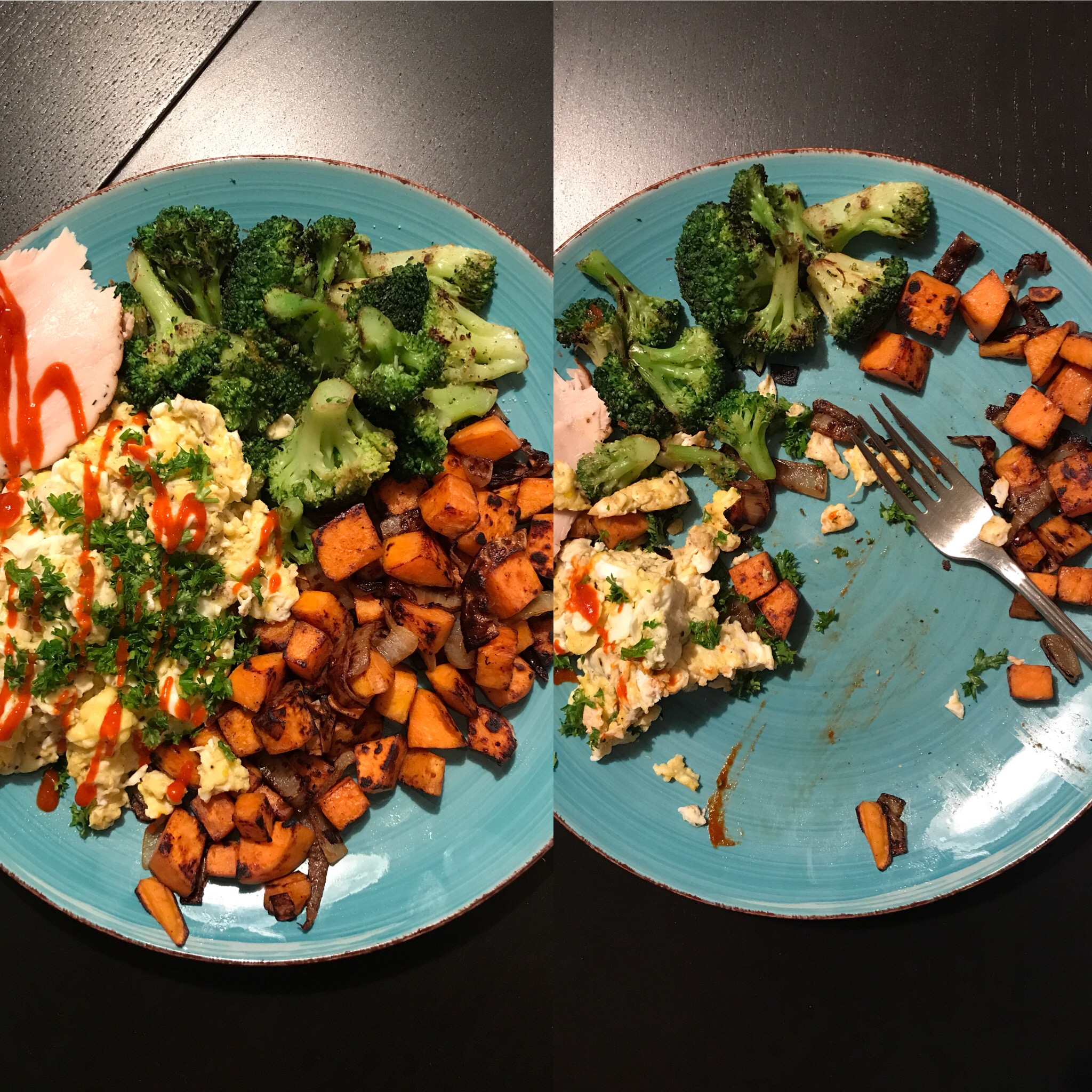Eat when you're hungry and stop when you’re satisfied. Sounds simple enough, right? But how many of you actually know how to do that? If you’ve tried, you’ve likely discovered it’s a lot more difficult than it seems.
Many of us have been conditioned to either eat when we think we should because it’s time or because we want to because something delicious entices us. We eat when we’re not hungry, and then we often overeat. This isn't entirely your fault though. We’re constantly being bombarded with food so it’s no surprise we feel the urge to eat even if we’re not actually hungry. We have stressful lives and it’s really easy to reach for food to comfort us after we’ve had a long day or we’re going through some tough times.
Ideally, we’d be able to ignore these distractions and deal with everyday stress or emotions without reaching for food. We’d only eat when we’re hungry and stop when we’ve satisfied our hunger. In fact, all of us were born with this innate ability to self-regulate how much and how often we eat, but over the course of our lives, many of us lost touch with our intuition.
If you’ve ever noticed that you seem to go from stuffed to straight-up starving with no in-between, then you’ve probably lost the ability to tune into your hunger and fullness cues. As a result, you’re unable to use them to help you control how often and how much you eat.
There are a host of factors that have diminished your ability to listen to these internal cues. Such as:
The abundance of super-tasty, highly-processed food
generally poor eating habits (eating quickly)
too much stress
your upbringing
poor gut health
hormonal imbalance
lack of sleep or poor quality sleep
The good news is that there is hope if you’re willing to learn how to recognize and listen to these sensations again.
In this final installment of the #basicAFnutrition eating habits series, I’m going to share a simple mindfulness activity that can help you rekindle your innate ability to self-regulate and control food intake. If this sounds a little hokey, I promise you, this definitely can work--especially when you combine this with all the other habits I’ve discussed in this series. With this approach, you'll be able to:
Eat when you’re actually hungry, stop when you’re satisfied and avoid overeating.
Know the difference between when you need to eat versus when you should or want to eat.
Be able to enjoy foods without stress in social situations (parties, weddings, and etc).
Develop a healthy relationship with food. You’ll judge yourself less and have more confidence in yourself around food.
Ultimately, you’ll be able to lose fat and weight with less stress and more success.
What is actual hunger?
Whenever I start working with someone I often ask, “Do you know or think about if you’re actually hungry before you eat?”, most of the time the answer is “No, not really”. People often eat when they aren't actually hungry and it's a big reason why so many struggle to lose weight.
How do you know if your hunger is legitimate and not brought on by your emotions? Our brains can get confused differentiating the sensations we experience during real hunger and emotional/mental hunger. How do you know you're eating for the right reasons? Before I jump in how to gauge your hunger and fullness cues, it’s important to recognize the differences between actual/physical and mental/emotional hunger.
This graphic will help summarize the differences:
You generally feel actual hunger in your stomach and in your body, whereas with emotional hunger, the urge to eat is rooted in your head and in your mouth. It's "above the neck". Emotionally-driven urges to eat often come out of nowhere and are usually for specific foods. If you’re truly hungry, you may want a cupcake, but you’ll definitely eat broccoli. If you’re having a craving or you’re emotionally hungry, you’ll likely only want the cupcake because it comforts you.
Understand that eating any kind of food won’t resolve emotional hunger. You may feel some emotional relief in the short-term, but over the long-term, your problems and emotions will still be present. If you ate something you didn’t think you should have, that usually leads to feeling guilty, ashamed, and/or powerless which then feeds into the vicious cycle of emotionally eating again. If you’re emotionally driven to eat, you need to find out what’s bothering you and what you are truly “hungry” for if not for food to even begin to break the cycle.
The Hunger Scale
Because some physical signs of hunger can still be brought on by emotions, you’ll still need to assess your situation. Did you just eat or has it been several hours? Did something stressful just happen or have things been building towards a meltdown? When you feel the urge to eat, you’ll need a way to specifically determine how physically hungry you are in order to make a mindful decision to proceed.
Before the first bite, I suggest taking a couple minutes to assess your hunger. If you’re reading this article, you’re likely in no regular danger of starving and hunger is not an emergency. You can take some time to listen to your body. Just check-in with yourself to see if you sense any of those physical sensations of hunger. Take 2-3 minutes to rate your hunger on a scale from 1 to 10. During your meal, focus on eating slowly and periodically “coming up for air” for a few seconds to pause your meal. During that pause, check in with your hunger to see if you could stop. At the end of the meal rate your hunger again and note anything you felt physically or emotionally during the meal.
Based on this scale, you’ll want to start eating around 6-7 and avoid getting into the danger zones of hunger around 8-10. When you get into those zones, it’s much easier to overeat or choose foods you otherwise wouldn’t because you're starving.
Try to stop eating around a 3 - 5. At this point, you’ll no longer be hungry but you won’t be uncomfortable and stuffed like you would be at a 1 or 2, merely satisfied and content. Declare to yourself, “I’m full”. Put your fork down, nudge your plate away, have the waiter take it or get up from the table. Commit to cutting off the meal.
If you have food left over that’s ok! I’m here to tell you that YOU DON’T HAVE TO CLEAN YOUR PLATE. I grew up in the clean plate home and you didn’t dare waste food. I totally get it. But that mentality isn’t helpful to you losing weight or eating mindfully. You’re just following programming and orders. That’s what robots do. You’re a human. Eat like one. As you learn more about how much you truly need to eat to be satisfied, you can adjust your portion sizes and make sure you only put what you need on your plate. No more waste.
Ya ain't gotta clean ya plate!
Need to Eat vs Should Eat Vs Want to Eat
The hunger scale will give you a good idea of whether you truly need to eat or if you could potentially wait instead of eating because the clock says to, or wanting to eat because there is food readily available. Also, if you tend to emotionally eat, assessing your hunger will likely stop you dead in your tracks or at least halt you temporarily.
But can you eat even if you’re not all that hungry? What if you know it’s going to be a while before your next opportunity or you feel better training when you’ve had something to eat but you’re not really all that hungry at the moment? By all means, go ahead and eat. You can always use the hunger scale to help manage how full you get.
This is important. Try not to overcomplicate things or stress about the details. Use the hunger scale as a general roadmap and try not to get bogged down by the numbers. The numbers are just there to guide you. Get out of your head and into your body with this activity. It’s more important to get in tune with how you feel and your sensations.
Practice makes progress
This is all going to be a bit of a learning curve, and like everything, it’s going to take practice. You won’t be an intuitive eating master on day 1. With time, it'll get easier.
The key is to periodically check in with yourself throughout the day and give yourself an opportunity to learn how you operate. I would suggest checking in with yourself 2-3 hours after you eat just to see if you’re approaching the 6’s or 7s on the scale. If you are, then eat. If not, then it’s ok to wait a little longer until you know for sure. Just keep checking in with yourself every 30 minutes or so. Make sure you have something quick, healthy and satisfying to eat just in case you start feeling hungry.
Keep a little hunger journal (on paper or in your phone with a notes app) to help you notice any patterns and be sure to keep notes of anything you notice about how you felt as you ate a meal. It may look something like this:
Meal 1: 12:15pm-12:25pm
Started: 8
Ended: 2
Was really hungry and wolfed down my food. Definitely a bit uncomfortable and bloated. Eat slower next time.
However you decide to approach this, just keep practicing listening to your hunger and fullness cues. Eventually, you’ll learn what makes you tick and you won’t need to rate yourself every time you eat. You'll just feel it.
Everyone can be mindful
I will admit this approach may not work for everyone. Some of you will need more structure or a different approach than just eating based on feel. If you’re a competitive athlete, someone who struggles with disordered eating, or you have a medical condition that affects your eating, you may not be able to solely use your hunger and fullness cues to determine how much or how often you eat. Like everything with nutrition, it really depends on your goals and where you are currently. However, I do believe that ALL of us can be mindful and aware of our hunger, fullness and eating patterns. You’re not a robot. You can eat mindfully.
Your Action Step
Now that you’ve seen the hunger scale, take some time before and after a meal to rate and assess your hunger. What physical or emotional sensations do you notice before, during and after the meal? What do you notice throughout the day? Do you skip meals or eat frequently? Do you get uncomfortably full often or do you not feel satisfied after your meals?
Knowing these things can help you improve your eating habits or give you insight on what kinds of foods you want to eat more of or even avoid. Whatever you do, just keep practicing. It’ll get easier over time and you’ll learn a ton about yourself and how much food you really need to reach your goals.
Hope you enjoyed this series and were able to take some things away from it. If you've implemented anything I've shared, let me know how it goes for you. You can always reach out to me in the comments below or send me an email.
Cheers,
Alex
Interested in working with me?
I'm offering a free consult call for those want change their lives with better nutrition. To see how I can help you, click the button below to schedule your free 1-on-1 call.



